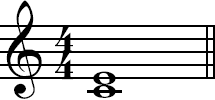Major third interval
 The major third interval consists of two notes with two whole steps distance. For example, C to E note will result in this musical interval.
The major third interval consists of two notes with two whole steps distance. For example, C to E note will result in this musical interval.
The major third interval is abbreviated M3 whereas the minor third is abbreviated m3. An alternate spelling of major third is diminished fourth.

A major third with C to E on the keyboard.
Listen to the major third interval (C-E):
To recognize this interval by ear, a good idea is to think of a familiar song whose two starting notes are matching the interval. An ascending example is "When the Saints Go Marching In" (C-E).
This interval is rare in the context of a scale formula and is known as a quadra step. It can be found in some exotic scales such as the Balinese and Chinese.
The major third plays a crucial role in chord construction. It is the third that decides if a chord has a major or minor quality. Chords with a major third interval between the first and second notes are in general major chords. For example, C consisting of the notes C, E, G and Cmaj7 consisting of the notes C, E, G, B.
Major thirds result in a pleasant sound and are often part of the harmonic in compositions. Below is a simple example with only major thirds intervals (some are inverted):

Ascending major third intervals
A list of ascending major third intervals:
- C – E
- C#/Db – F
- D – F#/Gb
- D#/Eb – G
- E – G#/Ab
- F – A
- F#/Gb – A#/Bb
- G – B
- G#/Ab – C
- A – C#/Db
- A#/Bb – D
- B – D#/Eb
Descending major third intervals
A list of descending major third intervals:
- C#/Db – A
- D – A#/Bb
- D#/Eb – B
- E – C
- F – C#/Db
- F#/Gb – D
- G – D#/Eb
- G#/Ab – E
- A – F
- A#/Bb – F#/Gb
- B – G
- C – G#/Ab
Enharmonic notes such as Cb and Fb are omitted.
A major tenth interval is the same as major third on next interval (or compound major third, which is the correct term).
Read more about intervals and use the interactive Piano Interval Finder tool.